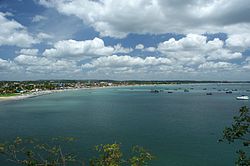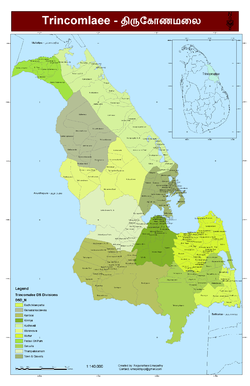Trincomalee
|
Trincomalee திருகோணமலை ත්රිකුණාමලය |
|
|---|---|
| City | |
| City of Trincomalee | |

View of Trincomalee Bay
|
|
 |
|
| Coordinates: 8°34′0″N 81°14′0″E / 8.56667°N 81.23333°E | |
| Country | Sri Lanka |
| Province | Eastern |
| District | Trincomalee |
| DS Division | Town & Gravets |
| Government | |
| • Type | Urban Council |
| • Chairman | Rubaraja Janoch (UNP) |
| Area | |
| • Total | 7.5 km2 (2.9 sq mi) |
| Elevation | 8 m (26 ft) |
| Population (2012) | |
| • Total | 99,135 |
| • Density | 13,000/km2 (34,000/sq mi) |
| Demonym(s) | Trincomalians |
| Time zone | Sri Lanka Standard Time Zone (UTC+5:30) |
Trincomalee (Tamil: Tirukōṇamalai, Sinhalese: ත්රිකුණාමළය Trikuṇāmalaya) also known as Gokanna, is the administrative headquarters of the Trincomalee District and major resort port city of Eastern Province, Sri Lanka. Located on the east coast of the island overlooking the Trincomalee Harbour, 113 miles south of Jaffna and 69 miles north of Batticaloa, Trincomalee has been one of the main centres of Sri Lankan Tamil language speaking culture on the island for over two millennia. With a population of 99,135, the city is built on a peninsula of the same name, which divides its inner and outer harbours. People from Trincomalee are known as Trincomalians and the local authority is Trincomalee Urban Council. Trincomalee city is home to the famous Koneswaram temple alluded to in its historic Tamil name Thirukonamalai and is home to other historical monuments such as the Bhadrakali Amman Temple, Trincomalee, the Trincomalee Hindu Cultural Hall and, opened in 1897, the Trincomalee Hindu College. Trincomalee is also the site of the Trincomalee railway station and an ancient ferry service to Jaffna and the south side of the harbour at Muttur.
The recorded history of Trincomalee spans more than two and a half thousand years, beginning with civilian settlement associated with the Koneswaram temple in the pre-modern era. One of the oldest cities in Asia, it has served as a major maritime seaport in the international trading history of the island with South East Asia. In the ancient world, it was successively the capital of eastern kingdoms of the Vanni country, developing under the Anuradhapura Kingdom, Pallava Dynasty, Chola Dynasty, Pandyan Dynasty, the Vannimai chieftaincies and the Jaffna kingdom through the Koneswaram shrine's revenue. Trincomalee's urbanization continued when made into a fortified port town following the Portuguese conquest of the Jaffna kingdom, changing hands between the Danish in 1620, the Dutch, the French following a battle of the American Revolutionary War and the British in 1795, being absorbed into the British Ceylon state in 1815. The city's architecture shows some of the best examples of interaction between native and European styles. Attacked by the Japanese as part of the Indian Ocean raid during World War II in 1942, the city and district were affected after Sri Lanka gained independence in 1948, when the political relationship between Tamil and Sinhalese people deteriorated, erupting into civil war. It is home to major naval and air force bases at the Trincomalee Garrison. The city also has the largest Dutch fort on the island.
...
Wikipedia

